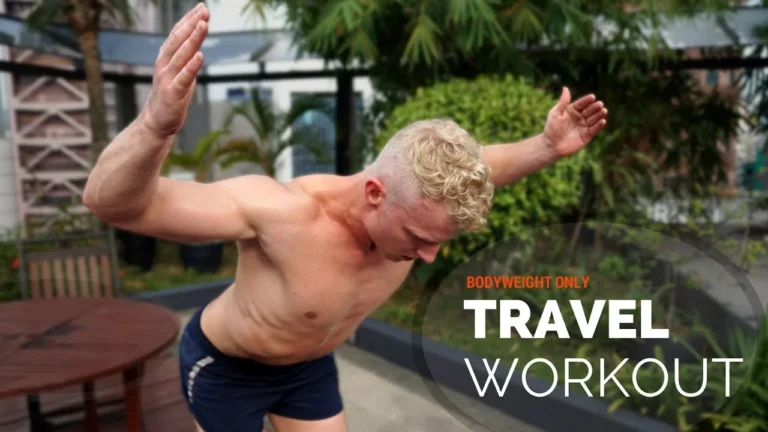Training Arms, Chest, Shoulders and Abs in Your Hotel Room
While travel often stresses the upper body areas, you can recuperate and reinvigorate with these natural strength moves right in your hotel suite.
Anyone traveling nowadays knows about the extra stress to upper body areas that most journeys involve. A day on the road sees you pulling suitcases, or carrying heavy briefcases or laptops on your shoulder. Then there are the periods spent in hunched or limited positions on planes, trains, or the highway. Often, this combination of demanding movement, along with the hours of immobility, can only be addressed after arriving at your hotel. Even if there is no gym on site, you can still use your hotel room to fit in a shorter version workout targeting the major upper body muscles one day, then train your lower body muscle groups on a following day — try the complementary Men’s Lower Body Travel Workout for balance and recovery.
Turn Your Suite Into Your Mini-Gym
When there’s no time for outdoors or health clubs, improvising right within the space of your accommodation can still provide a worthwhile session. Mark Saunders, an executive personal trainer in Tucson, Arizona, is enthusiastic about fitness routines on the road. “It can help reduce trip stress, burn extra calories from business meals and help ease the transition into your routine back home,” he points out. “It can also help you maintain regular sleep patterns in foreign beds and minimize the effects of jet lag.”
Take advantage of the surfaces and furnishings of your room for some stretching, cardio and strength movements. Lightweight rubber exercise bands are the key equipment to pack for on-the-road upper body training sessions. Aside from these and a jumping rope, the only other equipment will be a chair, bed, and a door frame in your room. You can even do in-place cardio drills — high-stepping, jumps, or lunges. Always train for intensity and efficiency: for instance, if you’re traveling for a week or more and you usually train at least four days a week at home, aim for a minimum of three days a week while you’re away.
For travelers who prefer mental focus alongside physical effort, short meditative breaks can help recovery and enhance muscular performance. Learn a simple mindfulness routine in How To Meditate – a Simple Meditation Technique.
Multi-Functional Exercises for Time-Pressed Workouts
Choose exercises that target several muscle groups at once. All of the following provide either core training or multi-muscle exercise. This approach not only saves time but boosts overall endurance and coordination — principles also emphasized in Active Body, Healthy Mind.
Warm-Up
- Jump rope, stair climbs, or running in place.
Upper Body
- Crunches – Start with abdominal crunches. Your lower back needs to decompress and stretch out.
- Reverse Crunches – Work the lower abdominals.
- Rotational Crunches – Target the obliques with more difficult side-to-side crunches.
- Knee Raises – Work the abdominals with sitting, lying or hanging knee raises.
- Crunches with Exercise Band – Use the band’s resistance to raise the torso.
- Push-Ups, Military Style – Excellent for pectorals, shoulders, and triceps.
- Push-Ups, Wide-Arm Style – A warm-up for the pectorals, deltoids, triceps and upper back muscles.
- Standing Flyes with Exercise Band – Target inner/outer pectorals and anterior delts.
- Tricep Dips – Use the edge of a stable chair; advanced version with feet on the bed.
- Tricep Push-Ups – Hands together forming a triangle under the chest, focusing on triceps.
- Tricep Pressdowns – Using an exercise band over a door, extend the arms downward flexing the triceps.
- Wide-Arm Pull-Ups – Use the upper door frame to lift up to shoulder level, targeting lats, biceps, and forearms.
- Biceps Curls with Exercise Band – Perform standing with the band looped under the feet.
- One-Arm Rows (with suitcase) – Use a medium-size suitcase to simulate one-arm rows, targeting lats and biceps.
- Upright Rows (with suitcase) – Curl a suitcase toward the chest to target the upper back and deltoids.
- Anterior Raises – Holding a phone directory or similar object, raise arms to shoulder level and slightly curl lower arms.
- Hyper-Extensions – Lie face down on a bed, extend arms and legs, and raise opposite arm and leg 2-3 inches to target the lower back.
For additional reading on exercise science and travel fitness, explore the NIH research on resistance band training effectiveness, which supports its benefits for strength maintenance and flexibility during travel.

